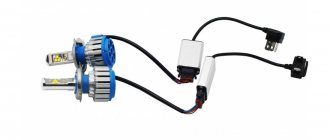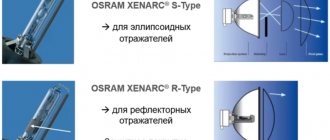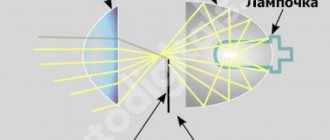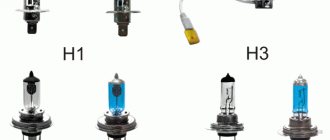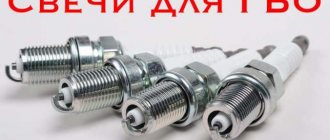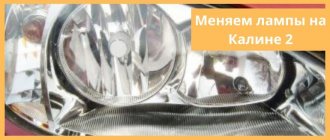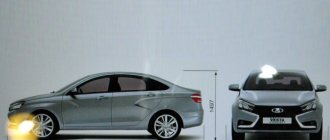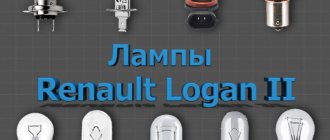Currently, LED headlight bulbs provide better illumination when compared to halogen, xenon and, of course, simple incandescent bulbs. But drivers, familiar with the fact that xenon often causes fines and deprivation of licenses, are wondering: is it possible to install LED lamps in headlights , will there be problems with the law, and how will the traffic police react to such tuning?
Specifically, the questions are identified according to the following subparagraphs:
- Is it allowed to install LED lamps in low-beam headlights;
- Necessary headlight markings for installing LED lamps;
- Is a headlight corrector and washer required if they have LED bulbs?
- Possible fine for installing LEDs in headlights.
On June 25, 2022, the Supreme Court of the Russian Federation issued explanatory resolution N20, in which in paragraph 6 it explained that the police should consider such cases based on part 1 of Article 12.5 of the Code of Administrative Offenses of the Russian Federation ( warning or fine of 500 rubles ).
Real operating conditions of LED lamps
Replacing halogen lights with LED lights in a car's parking lights with regular white LEDs that do not change their color (like decorative lighting or installing LED lighting in the cabin) cannot be regarded as a violation of the light indication mode.
The presence of an LED lamp in the side headlight can only be proven by dismantling the headlight cover; naturally, no one will do this. Therefore, the answer to the question whether it is possible to install diode lamps in dimensions is definitely “YES”.
The main problems arise when installing headlights in headlights. The light beam angle of a conventional LED matrix is about 120 degrees, which is significantly less than that of halogen lamps.
A standard reflector in a headlight is not capable of providing the necessary focusing of the light flux under such conditions; this worsens the illumination of the roadway and can blind oncoming drivers. Naturally, such car owners will inevitably be held accountable.
Today, LEDs in headlights are installed as standard only on electric vehicles and some hybrid vehicles. Therefore, in the operational documentation of the vast majority of cars, the class of LED lamps is missing as such.
Thule Freeride 532 roof bike rack: design features
- for long-range illumination, luminous flux from 1500 lm;
- for the neighbor at least 1000 lm;
- total power of at least 17 W with an efficiency of 100 Lumens per Watt;
- the presence of an active or passive cooling radiator.
Please note that manufacturers often indicate the total brightness. It’s also not worth buying too bright ones, since this is more of a marketing ploy than a real benefit.
Fog lights
Most often, motorists change halogens to LEDs in PTFs, using base H11 and H8. They do not perform a primary role, so traffic police officers have a minimum of questions about them.
But due to the wrong approach, many choose 400-700 lm light bulbs. In the end, it turns out that halogens worked much better.
To ensure that the LEDs in PTF do not disappoint you, choose a brightness of at least 900-1000 lm. The less powerful ones become meaningless and useless.
A few years ago, mass production of special diodes with a yellow cap and position adjustment began. This allows you to make them into a full-fledged imitation of a halogen lamp. With such optics, traffic police officers will definitely not be able to find fault.
parking lights
The base used here is W5W T10. Marking T10 T5 is also found. The assortment is huge, which is somewhat confusing for car owners.
Nominally the power should be 5 W, and the brightness should be from 50 lm. There is no point in increasing these parameters excessively. The more powerful the LEDs, the faster they fail. This is due to overheating.
Most motorists prefer devices with 1-2 watts and 50-100 lm.
Whether to install diodes or not is a purely personal decision. I just want to suggest when it’s not worth doing this, and in what situations there are no real obstacles.
Thank you all for your attention! Subscribe, leave comments, ask questions!
Comparison of halogen lamps with LED lamps while driving
It is not entirely correct to compare from photographs how headlights shine with different types of lamps, since photographs do not reveal the sensations of driving at night. In order to really find out which lamps were better, it was necessary to drive a car at night, with different types of light bulbs.
As a result, as a result of testing, we found that, in comparison with conventional halogen lamps, headlights with LED low beam lamps shine more efficiently.
The only thing we paid attention to when testing while driving was the dispersion range (beam of light). As you can see in the photographs, the brightness of LED lamps significantly exceeds the brightness of halogen lamps (even expensive and powerful ones). But, nevertheless, halogen lamps have a large beam range, which is indispensable while the car is moving. For example, if you are driving in complete darkness, then the illumination range of the road itself plays a significant role in safety
In such driving conditions, the range of the light is more important than its brightness in front of the car
Advantages of LED car low beam lamps
– You can see every small pebble on the road in front of the car within 10-15 meters. Due to the brightness of LED lamps, when driving in the dark, you will feel like the night is over. By the way, this can play an important role when driving for a long time at night. The fact is that the more light there is, the less risk of falling asleep while driving.
– Your headlights will shine very brightly, which increases the visibility of your car on the road to other drivers. Even from a great distance on the highway, your car will be easily seen by other drivers who are moving towards you.
– Reducing the load on the vehicle’s electrical system (including the battery). Especially when you use a car refrigerator or other energy-intensive equipment connected to the car's cigarette lighter.
– Stunning appearance. Yes, the front optics, where LED low beam lamps are installed, look very stylish and beautiful. From a distance, your car will be indistinguishable from expensive premium vehicles.
Disadvantages of LED car low beam lamps
– Despite the correct adjustment of the headlights, LED lamps produce a very bright light, which at close range can blind drivers moving towards you.
– Small range of the light beam. Small dispersion range. This is a big disadvantage for high-speed driving at night. Halogen lamps have a longer illumination range and do not blind oncoming drivers.
– LED lamps that come with retrofit kits and are presented on the automotive market are not entirely legal. So, despite the fact that most LED lamps are certified in Russia, according to current legislation, it is not entirely legal to retrofit a car with LED low-beam lamps if the car manufacturer itself has not provided for this possibility at its factory.
Let us remind you that any changes to the design of the machine that may affect road safety must be certified and approved by the traffic police.
However, despite the fact that the installation of LED low beam lamps is not entirely legal, many drivers in recent years have begun to equip their vehicles with them en masse. This is due to the fact that in most cases the traffic police do not have the opportunity to check on the road what types of lamps are used in the car. As a rule, special equipment is required for this.
The only place where car owners may encounter problems is after installing LED lamps in a technical center, when passing a technical inspection. In accordance with current standards and legislative acts, if lighting elements are installed on a vehicle that do not comply with established GOSTs, then the vehicle will not receive a positive inspection report.
Is there any point in doing it yourself?
First of all, it is worth saying that despite the fact that the forums are replete with various know-how from “experienced” people, there is no one to boast of such a home-made design that would work for a year in cold winters and hot summers. But even if there were unique people who were able to make all the calculations correctly and take into account all the nuances of operating diode lamps in headlights, then how much will you have to pay for this? Let's count:
- The radiator will cost at least 2,000 rubles, most likely it will require a fan, which costs a little more, from 2,500 rubles.
- 2 stabilizers are another 400 rubles.
- 2 drivers (PWM possible) – 500 rubles.
- 8 LEDs for each headlight - at least 1,600 rubles.
- Optics for diodes will cost another 500 rubles.
Total, 7,500 rubles for a rather dubious project. And this is without taking into account the processing of the headlight, which will definitely be required for a homemade design. In addition, even if you solve all the problems associated with how to fit the optics, the issue of focusing the light beam and the cooling system will remain open.
Choosing halogen lamps for cars
Based on their structure, halogen lamps for cars are divided into the following types.
- Flanged.
Used in headlights, fog lights, spotlights. The most modern and bright model - H7, is characterized by bright, but not blinding light. The slightly less bright model of halogen lamps for cars H4 is also in demand.
Pinned.
On the cylindrical base, symmetrical or, less commonly, offset pins are noticeable.
Soffit.
They are used for interior lighting of car interiors, as well as in turn signals.
Baseless.
They can serve as dashboard lighting and side lights. Very durable.
Light bulbs with glass-plastic socket.
Usually the dashboard is illuminated.
Bulbs with a plastic sealing base.
Based on the H7 model, these smaller bulbs can be called H8, H9 and H11. They are used in the smallest headlights.
Is it possible to install H7 LED lamps in low beam?
The answer to the question is contained in clause 4.3.1 of GOST R 51709-2001, which is a reference to the provisions of GOST 8769. It clearly states that on vehicles traveling on the roads of the Russian Federation it is allowed to install:
- incandescent lamps (C);
- xenon (gas-discharge) lamps (D);
- halogen lamps (H).
There are no LED light sources in GOST.
For experimenters who neglect the requirements of traffic rules, it should be remembered that all external vehicle lighting devices must comply with the requirements of GOST R 51709-2001. Before installing an LED lamp on your car, you should study the markings on the outside of the headlight reflector:
FIGURE 2
Types of headlight markings in accordance with international standards 41.99-99
What about LED bulbs that actually emit a beam of light correctly?
photo: eneltec-led.com
As we see, large players are already entering the fight for buyers. Perhaps they make the perfect replacement parts?
As an expert from the USA says:
“A number of the more prominent companies selling, developing and testing LED HID headlight bulbs in 2022 are trying to mimic incandescent bulb placement to solve this problem, but that’s only part of the equation.”
Daniel Stern also explains why an LED with physical parameters similar to a regular light bulb (identical size and shape) will not work in reality:
“The longitudinal position of the light source (where the light source starts and ends as measured by a basic incandescent light bulb) is only one important aspect. But it's not just him. The shape, size, orientation and distribution of the light beam, as well as the brightness of the source, are also extremely important. Getting one out of five correct is better than zero out of five, but it's still 20 percent of par and that's a very bad score."
“If we could wave a magic wand and create a cylindrical LED emitter the same size as an incandescent lamp with the required brightness and lumen output, then the incompatibility would disappear. This is technically impossible for the foreseeable future, so we mostly have flat 2D LEDs instead of the 3D shape of a traditional light bulb.”
Daniel continues:
“There is a certain space between two flat LEDs located back to each other (there must be, otherwise there will be nowhere to place the material that removes heat from the heating of the working lamp), thus, our light source is radically different from the usual lamp both in shape, size, and and by the position and distribution of light. Even if we made every effort to place the emitters in exactly the same longitudinal position as the original filaments, this would not work for a number of reasons, both physical and economic.”
Installing LED headlights instead of halogen ones
Let's consider another option - completely replacing halogen headlights with LED ones. In this case, there is a violation of the same paragraph 3.1 and the fine for violation is 500 rubles.
However, in this case it is possible to legalize LED light bulbs. To do this, you need to obtain a certificate of compliance of the vehicle with the changes made to its design with safety requirements, and then re-register the car with the traffic police.
So, if you have documents for LED headlights, you can legalize them and not pay fines.
In addition, the situation is much better if vehicles of a similar model are equipped with LED headlights. In this case, the driver will not have to undergo a safety test. Clause 77 of Section 4 of Chapter V of the Technical Regulations of the Customs Union:
1) when installing components on a vehicle:
intended for this vehicle and have undergone conformity assessment as part of this vehicle, which is confirmed by the documentation of the component manufacturer;
provided by the vehicle manufacturer in the operational documentation;
2) when serial changes are made to the design on the basis of design documentation developed and approved in the prescribed manner, if on its basis an assessment of the conformity of the changes made was carried out.
To comply with the regulations, you need to install headlights that are installed on cars of a similar model. Such a replacement should not cause problems when communicating with traffic police officers.
In conclusion, I would like to note that replacing halogen headlights with LED ones can cause problems in the operation of the car's electronics. This is due to the fact that different types of lamps have different resistances. So in practice, it may not be enough to simply change the headlights and you will have to additionally change the headlight control unit. Keep this in mind.
Security measures
To prevent electric shock and damage to auto parts, you need to follow a few simple tips:
- Before starting work, remove the terminal from the battery and reinstall it after installing the headlights.
- Remove lamps carefully to avoid breaking the glass. If the block does not come off the contacts, do not use excessive force.
- It is recommended to wear gloves to avoid scratching protruding elements with your hands.
- Provide good lighting for the work area.
For clarity, we recommend thematic videos.
If the headlight fits under the LED bulbs, it is easy to install. There is no need for a complex circuit or special device; everything is done in almost the same way as when installing conventional halogen options.
LED lamps Optima COBALT H7 LED Premium 4800K
Another popular manufacturer offers bright LED headlights. Unlike Philips lamps, these lamps are built on other LEDs - CREE XHP-50.
Lamp characteristics:
- Type head light
- Diode type CREE XHP-50
- Color temperature 4800K
- Number of diodes 2
- Power 20 Watt
- Operating voltage 12-24 volts
- Operating supply voltage 3 A
- Cooling Heat pipe with coolant and flexible radiator
Power parameters:
- Cold lamp 12V-2.72A - 32.64W
- Operating condition 20 min at 25°C 14.1V- 1.98A-27.9W
- Operating condition 300 min at 55°C 14.1V-1.91 A - 26.9W
That is, from the lamp parameters you can see that the output voltage on a cold lamp is 32.64W as the heating temperature increases, the power of the lamp decreases, and with it the brightness. It is worth noting that this applies not only to Optima lamps, but also to other LED lamps.
The cost of Optima COBALT H7 LED Premium 4800K lamps is about 7 thousand rubles.
Can the traffic police cancel a car’s registration for LEDs?
Yes, easily. But only if you do not comply with the requirement to provide a car with working optics.
Let's look at how this happens in practice:
- You are driving a car with non-standard LED lamps instead of halogen light sources.
- The traffic police inspector notices the light from your car is too bright and stops you. After some simple manipulations, it detects a discrepancy between the light source (diodes) and the headlight markings (halogen).
- Next, the traffic inspector draws up a resolution with a fine under Part 1 of Art. 12.5 of the Administrative Code and lets you go home.
- At the same time, the policeman writes a report to his boss about the detected offense. After all the checks, you will receive an order from the traffic police to submit a working car for inspection within 10 days (that is, with light bulbs that match the headlight markings).
- If you ignore this instruction, the traffic police MREO will automatically stop registering your car. And the limitation will remain until you fix the problem with the headlights.
After deregistration of the vehicle, you will have to hand over the paper PTS and STS to the traffic police department yourself. In addition, you will lose your previously assigned registration numbers (including “beautiful ones”). If you don’t turn them in, they will be put on the wanted list, and after the next stop on the road, your license plates will be confiscated and your car will be sent to a special parking lot.
Driving an unregistered car is prohibited. If you are stopped by traffic police inspectors, you will be fined from 500 to 800 rubles (part 1 of article 12.1 of the Administrative Code). If you violate it again, you may be left without a license for up to 3 months.
Top 1. Xenite 1009054
Rating (2021): 4.63
33 reviews from resources were taken into account: Yandex.Market, Ozone, Otzovik
Best price
The most inexpensive LED lamp in our rating. The price of 440 rubles per pair is almost two times lower than that of its closest competitor.
- Characteristics Price per pair: 440 rub.
- Country: Russia (manufactured in China)
- Power (W): 27
- Voltage (V): 12
- Color temperature (K): 4300
- Luminous Flux (Lum): 2500
- Service life: 50,000 hours
A car LED lamp in the H7 form factor is not the cheapest pleasure. Better models from well-known manufacturers can cost several thousand rubles, but in this case we are seeing the cheapest option, costing half the price of its closest competitor. At the same time, the lamp cannot be called bad, nor can it be called the best of its kind. The product is quite simple. The working life is 50 thousand hours, and the luminous flux is 2500 lumens. In principle, everything is adequate, but the low level of protection should be taken into account: if your lensed optics have leaks, you should be very careful when washing the car. But there is a one-year warranty.
LED lamps H7 Philips X-Treme Ultinon - 12985BWX2
High-quality LED lamps Philips H7 X-Treme Ultinon for low/high beam headlights, as well as fog lights of some cars. The lamps, as we wrote above, are certified and have a quality certificate. The manufacturer gives a 3-year warranty on the lamps and promises a service life of up to 12 years.
Lamp characteristics:
- Length - 74mm
- From the base to the edge of the lamp - 45mm
- From the base to the edge of the radiator - 29mm
- Radiator diameter - 40mm
Converter block
- Length - 46mm
- Width - 21mm
- Height - 11mm
- Length including wires - 250mm
The lamps are built on high-quality Luxeon Z ES LEDs which, according to the manufacturer, produce 1750 lumens.
Main characteristics
- Voltage: 12V;
- Power consumption: 25 W;
- Color temperature: 6000K (up to 6500K);
- Luminous flux: 1760 lm;
- Service life: up to 12 years
For comparison, the promised 1750 lumens is not so much compared to Chinese LED lamps that supposedly produce 4800 lumens and even more. The standard xenon has a brightness of 2800-3200 lumens.
The cost of LED lamps H7 Philips X-Treme Ultinon - 12985BWX2 is about 8-9 thousand rubles.
Uralets trailer: technical specifications, price, customer reviews
- Due to the size of the radiator, LEDs sometimes make it difficult to put on the sealing cap for car headlights;
- the design of the headlight does not always correspond to the design of the LED, which makes the light boundaries insufficiently clear;
- The power is 3 times lower compared to halogen, so LEDs cannot always protect the optics from icing in winter (little heat is generated).
Let's move on.
High beam
The H1 base is used here, which imposes more power requirements. The prices for LED high beam headlights vary widely. But here quality is closely related to cost.
There is a lot of controversy and talk regarding LED-based high beams. Moreover, the majority considers this not the most correct decision.
The minimum characteristics should be:
- power from 17-20 W;
- luminous flux from 1500 lm;
- presence of a radiator.
The disadvantages are similar to low beam headlights. As practice shows, it is better to leave high beams based on halogen. There's too much risk of not getting what you wanted.
Near/far
LEDs on the H4 socket are different in that a pair of powerful LEDs are combined in one lamp. The low beam is located at the top, and the diode responsible for the high beam is at the bottom.
When choosing such a design, it is better to give preference to more compact models. The headlights of the car were originally adapted for spiral halogens. Therefore, for diodes, their dimensions should correspond as much as possible to the dimensions of the spirals.
The performance requirements are:
What lamps are prohibited on cars, headlights
Light sources that technically do not correspond to the type of lens of the lighting fixtures are prohibited without reservation for the headlights of a car:
- if the headlights are designed for incandescent lamps, halogen, xenon and LED cannot be installed;
- for halogen devices the other three types of light sources are unacceptable;
- if the headlights are initially adapted for xenon, it is prohibited to use LEDs, incandescent and halogen lamps;
- All sources except diodes are not suitable for LED devices.
That is, the classes of headlights and the light bulbs used in them must match. If this is not the case, the car owner has arbitrarily made a prohibited change to the design of the car, which must be eliminated.
Watch this video about which lamps are prohibited from being used on a car:
What exactly do we mean by LED headlights?
In this article we will talk about the types of LED lamps (note: the abbreviation LED stands for “Light Emitting Diode”) that are placed in the housing of car headlights, the latter of which were originally designed to work with halogen incandescent lamps. Typically, such an installation is simply called “LED lamps.”
Of course, we will not consider here cars that are equipped with LEDs from the factory, or so-called high-intensity discharge (HID) lamps and other offshoots. LEDs only.
Installing LED lamps in halogen headlights
Now let's move directly to the issue of installing LED lamps in halogen headlights and possible liability for such actions. The process of installing lighting devices itself is not technically difficult, but it conflicts with the List of faults prohibiting the operation of vehicles, paragraph 3.1 of which states: The situation is explained by the fact that a lamp based on light-emitting diodes differs slightly in light characteristics from a halogen lamp, and its use with halogen-optimized reflectors violates the operating mode of the lighting device, as indicated in paragraph 3.1.
In practice, replacing halogen with LEDs does not make such a difference as, for example, replacing with xenon lamps. The exception is cheap Chinese models of LED lamps, the cut-off line of which can be quite blurred.
As a result, we can formulate the conclusion that the reflectors of halogen headlights with LED lamps do not distort the light characteristics as much as happens with xenon.
Options for using LED headlights
The operation of any vehicle involves only three options for using LED lamps, two of which are permitted by law:
- high or low beam lamps with light-emitting diodes are already installed in the car at the manufacturer's factory;
- independent installation of LED high or low beam lamps, if more expensive models of this vehicle series provide for their installation;
- installation of LED bulbs in standard halogen headlights of a vehicle.
In the latter case, the traffic police inspector may have claims, the validity and nature of which we will consider further.
How to choose h7 LED lamp
- Study the declared characteristics of the model you like, especially the size compliance with the car brand.
- Determine the presence and authenticity of the quality certificate. Products that have passed the necessary tests last longer than non-certified models.
- Functional properties should not contradict current safety indicators (GOST R 51709-2001). Despite the absence of LED and xenon bulbs in the list, this does not prevent car enthusiasts from actively using them.
- Optimal ratio of cost and declared parameters. You should not buy the cheapest sample, even one with excellent characteristics.
- Take into account indicators such as driver size, diameter and length of the device. Different auto optics have different amounts of free space. You need to know the distance from the diffuser to the bottom of the cover in order to choose a suitable lamp.
- The procedure for attaching the light source. If the adapter is not installed by the manufacturer, then you need to select a plastic or metal adapter.
Connection and pinout of lamp H4
To connect light bulbs correctly, you do not need to understand the design. High-quality products should be equipped with a standard connector in which the contacts are always the same.
The pin layout is standard for all manufacturers and does not depend on the type of light in H4 lamps.
If for some reason you need to install the connector yourself, use the pinout diagram shown above. Here's how to arrange the wires for the light bulb to work correctly. The connection is always made through the block; You can’t just twist the wires or wrap the joint with electrical tape.
It is important that the base/socket design matches standard halogen. If this is done incorrectly, the light distribution will be disrupted and it is unlikely to be adjusted.
It is better to buy light bulbs from well-known manufacturers; cheap Chinese products do not provide normal quality of light.
Thematic video.
Best Standard H7 Halogen Bulbs
On AliExpress you can choose decent models. The best H4 LED lamps 2020-2021 are presented in several models, sorted by quality and characteristics.
XsTorm
View on Aliexpress
Advantages and disadvantages
shines well in the fog; shines brightly even in the dark; withstands high temperatures; slightly brighter than 55W bulbs.
the bases are heated; when heated, the bases smell of burnt plastic; sometimes they are defective; the light is too white and not natural.
| Characteristics | Index |
| Size | 10x34x54 mm |
| Material | Halogen, glass |
| Price | 146 RUR/set |
I like it I don't like it
Meishangyang
View on Aliexpress
Advantages and disadvantages
shines well in the fog; will shine brightly even in heavy rain; shines bright white even at dusk; high power; higher light output; withstands high temperatures.
bright white light may harm other drivers on the road; only 55 W; too bright white light.
| Characteristics | Index |
| Size | 10x34x54 mm |
| Material | Halogen, glass |
| Price | 175 rub./set |
I like it I don't like it
Joshnese
View on Aliexpress
Advantages and disadvantages
will be bright, even with heavy rain; shines well in fog; withstands high temperatures; has a unique aluminum radiator; easy installation; high performance; low power consumption; long service life; price; protected against overload and short circuit.
the product is not certified; sometimes there may be a defect; There is only one piece in the set.
| Characteristics | Index |
| Size | 30x30x50 mm |
| Material | Halogen, glass, LEDs |
| Price | 170 rub./1 piece |
I like it I don't like it
This was a small selection of standard models that differ in their characteristics and also in their price range.
LED lamp "INTERPOWER H4 LUMILEDS"
The developers have created lamps with bright light emissions that do not leave blind spots at night and prevent dazzling oncoming cars.
The advantages are as follows:
- Power consumption is 40 W.
- The design of the light bulb includes 16 diodes.
- LED bulbs have a very long lifespan as they last for 50,000 hours.
- The LED lamp has a built-in cooling system and a weather protection element.
- Creates a very bright glow up to 4800.
- Light bulbs are sold in a box of two pieces.
- They are universal in use.
- It is possible to repair them.
Disadvantage: an amateur cannot handle the repair on his own, so you will have to contact a professional service for repairing these lamps.
LED lamp “4Drive LumpLED H4”
LED lamps are available in 2 pairs per pack, have a bright light emission of 3800 Lumens, and are easy to install.
Their advantages are as follows:
- The body is made of aluminum.
- The design has a built-in ventilation system that prevents the bulbs from overheating when they are in working condition for a long time.
- The light bulbs are shock-resistant, which protects them from external damage.
- Has a long service life of about 5 years.
- You can install it yourself and do not need the help of professionals.
- The lighting in front of the car captures at a distance of 500 m.
- They don't blind opposing cars while driving on the highway.
- They cool down quickly.
- Color temperature is 6000k.
- Power consumption 36 W.
Disadvantages: In some cases, certain weather conditions may blind oncoming cars.
LED lamp "Philips H4 Philips X-Treme Ultinon"
Another option for good LED lamps for cars is Philips. The plant produces various lighting products, which are significantly characterized by bright lighting and quality.
Among the advantages of LED lamps are:
- Can be used for both near and distant illumination.
- The power of the light bulb is economical, 23 W.
- You can independently adjust the projection without spots.
- The color glow is powerful 6200k.
- Average service life is 5000 hours.
- Very bright lighting on the road.
Flaws:
- the price is too high;
- in most modern cars, the headlight housing is not suitable for a lamp;
- Not suitable for all cars.
LED lamp "CARCAM H7"
Excellent value for money, it has proven itself so well when drivers review LED lamps for cars.
The advantages of this LED lamp are the following characteristics:
- One LED bulb lasts 30,000 hours.
- The light bulb uses IP68 protection class.
- The structure is made of aluminum alloy.
- Color temperature is white and 5500k.
- Withstands temperature changes from -45 to +150 degrees.
- The luminous flux is 3500 Lumens.
- Each bulb has 8 LEDs, of which 4 are in each.
- There is a built-in cooling system.
Disadvantages: After a long period of use, the lights may flicker.
LED lamp "4Drive H11"
LED ice lamps for cars are suitable for budget use. The bulbs have high-quality settings and can be sold in stores separately, that is, 1 piece per box.
The advantages of this LED lamp are as follows:
- Long service life is about 5 years.
- The design uses high-quality LEDs from Philips.
- LED lamps provide bright light.
- You can adjust the lighting settings yourself.
- The design of the light bulb has a cooling system.
- The light bulb is created with a waterproof surface.
- Color temperature is 6000k.
Flaws:
- in some cars the light bulb does not fit into the headlight shape;
- towards the end of its life, flickering may appear.
LED lamp "Optima Premium Fog H11"
The Chinese surprised us with the production of premium LED light bulbs, which are available to everyone at a budget price. Its peculiarity is that the lamp lenses are made of optical fiber, which creates a different flux of light.
The advantages of LED lamps are as follows:
- The long life of the bulb is 20,000 hours.
- Can be installed on any type of vehicle.
- The manufacturer provides a warranty on the light bulb for up to a year.
- A cooling radiator is built into the design of the light bulb.
- The light output of the lamp can be 4200k and 5100k.
- The design uses the latest generation lamps using special CREE-XM-L2 technology.
- The brightness of the bulb is 1350 Lumens.
- Has an economical consumption of 10 W.
Flaws:
- After prolonged continuous operation, the lights begin to flash.
- Light brightness may be reduced.
“World of Trailers” company product range, geography and customer reviews
But the whole point is that your offense still needs to be proven. According to the law, technical condition can be monitored only at stationary posts. Only a traffic police officer has the right to do this if he has the appropriate qualifications and diagnostic tools. And this tells us that ordinary traffic police officers technically and due to their qualifications cannot confirm the fact that you have LED optics.
The question is whether you are ready to constantly defend your rights, argue with law enforcement officers and take risks. Personally, I don’t see the point of putting LEDs on a car if the car’s design does not provide for it. You can get by with standard halogens.
Another question is if LEDs are required by law in the maximum configuration for your car. Even though you have the basic version, this still allows you to supply the required LED lamps yourself.
Technology
You probably already know how a regular incandescent lamp works. The man who invented the incandescent lamp entered the history of mankind and its development. After all, thanks to lighting, the whole world has been transformed, and industry has received a new round of development. As you know, the idea was simple. A piece of wire in a transparent glass flask was connected to electricity, which ultimately produced a glow due to the incandescence of the wire. A similar experiment today can be done by any student in a primary educational institution.
A halogen lamp has almost the same meaning of operation of a traditional incandescent lamp. The only thing is that the technology has simply been improved. So a buffer gas is placed in a glass flask: halogen vapor (bromine or iodine). Thanks to this, it is possible to increase the temperature of the coil and increase the service life of the lamp. Thus, thanks to this halogen lamp, it was possible to increase the light output.
In the picture we give to compare the two types of lamps, you can see regular halogen car lamps and a set of LED low beam lamps.
The manufacturers themselves, in order to increase the light output efficiency of LED lamps, have built into their design a parabolic aluminized reflector, which increases the focus of light (remember that LED headlights have a very small focus of light output due to the peculiarities of their design).
A parabolic aluminized reflector is essentially a simple convex aluminum tube, which, like a mirror, reflects light, distributes it in space, and then directs the collected light in a certain direction.
Also pay attention to the back of the LED lamp, where you can see a silver element, which is a “radiator” for cooling the lamp itself. Yes, of course, LEDs do not produce much heat and do not heat up in the front part, despite the bright and powerful light
But heating still occurs behind the diodes. After a few seconds of operation, you can hardly touch the back of the LED lamp.
Also, next to the “silver cooling radiator” there is a power wire with a connector for easy disconnection of the lamp from the electrical system (for example, if replacement is necessary). The LED lamp itself is connected to a connector from which a wire goes to a resistor to compensate for the voltage range, which may not be the same in different brands and models of cars.
So a fine or deprivation in 2022? Arbitrage practice
The decisions of the Plenum of the main court are binding for the guidance of lower courts, but not for their unquestioning execution. This is true, because the judicial system in our country is not precedent-based, and each case must be considered individually, taking into account the specific circumstances of the case.
Now comes the fun part! Do you think the lower courts began to follow the clarifications of the Supreme Court? Very reluctantly and not always. Actually, let's look at specific examples.
Practice of imprisonment for LED and xenon
- The magistrate of the Tula District Court upheld the decision of the lower court and sentenced the driver under Part 3 of Article 12.5 of the Code of Administrative Offenses of the Russian Federation. At the same time, the argument from the Resolution of the Plenum of the Supreme Court in the complaint about the illegality of deprivation for xenon, as well as in the explanations of the judge himself, is absent. That is, the court simply upheld the punishment, indicating that the operating mode of the headlights was violated, and referring to GOST and traffic rules.
- Another court decision from Ufa upheld the ruling under Part 3 of Article 12.5 of the Administrative Code. However, here the driver tried to appeal to two arguments. Firstly, he did not own the car and he was not aware of the inappropriate types of lamps. Secondly, the driver raised the question of the need for special knowledge in the field of automotive technology to resolve the issue of the operating mode and color of the headlights. The judge did not take these arguments into account and left the deprivation of rights in force. This decision also does not include the opinion of the Supreme Court of the Russian Federation.
- And here is another similar decision from Yekaterinburg, where a driver was deprived of his license for xenon headlights.
Something else useful for you:
- Is it possible to install LED bulbs in fog lights?
- Is it possible to install xenon in fog lights?
- Are rights deprived for LED lamps?
Converting a fluorescent lamp into an LED lamp
Converting a failed fluorescent lamp into an LED lamp is a very good idea. Diodes with comparable power consumption shine brighter and last longer. The method of converting a fluorescent lamp into an LED lamp depends on the type of lamp itself.
Types of luminaire designs for fluorescent lamps:
How to convert a linear fluorescent light into an LED one
If you have a lamp with a linear body, converting it into an LED version is not difficult. The easiest way is to use diode strips. There are even options for connecting to a 220V network without special power drivers. Their peculiarity is that all LEDs are connected in series and the output of one of them will render the entire segment inoperable.
The connection diagram is very simple:
Characteristics of 220V LED strip:
- Matrix type: SMD 5050;
- number of diodes per linear meter: 60 pcs. (60 x 3.5V = 210V);
- load power: 10W;
- luminous flux: 2100Lm.
In terms of brightness, a meter of such tape will correspond to an ordinary 100W incandescent light bulb.
Design advantages:
Very simple and quick installation and connection.
Design disadvantages:
- Due to the lack of a smoothing capacitor, the LEDs flicker at a frequency of 100 Hz. According to sanitary standards, such lighting sources cannot be used in residential premises.
- Along the entire length of the tape there are a large number of contact pads through which 220V voltage passes. To prevent short circuits, this type of tape is produced only in a sealed case, which makes repairs difficult if one of the diode matrices burns out.
- The minimum segment length of 50cm makes it difficult to create compact structures.
The main disadvantage of such tapes is high-frequency flicker. It is practically not perceived by vision, but causes rapid fatigue when performing precise work or reading. The problem is partially solved by installing a high-voltage capacitor in front of the diode bridge at the rate of 60-70 μF x 500V per 10W of tape power.
How to convert a fluorescent table lamp to LED
It will not be possible to remake such a lamp with little effort by installing a 220V strip there. With a minimum segment length of 50cm, it will not fit into the body, and its design has a very negative attitude towards bends. In such a lamp you can install several strips of diode strips designed for a voltage of 12V.
The optimal design option in this case is:
We use four 25 cm strips with 12V wiring. As a result, the brightness will be at the level of 75W of an incandescent lamp.
Power supply for compact lamp
A meter of tape consumes about 15W and is designed for a current of 1.2A. For such power, it makes no sense to buy a 30-watt specialized driver. You can use a ready-made factory solution. This miniature power supply with a total power of up to 20W. But the dimensions of 79 x 30 x 24 mm will not allow it to fit into the lamp body.
You can assemble a compact switching power supply with your own hands according to the following scheme. Capacitor 20-30 uF x 400V, zener diode 9-12V.
How to convert base fluorescent lamps into LED lamps
There are two options for modifying such a light bulb into an LED one:
- use of diode strip segments;
- Compact lamp with bright LEDs.
Conversion for LED strip
Materials for conversion and connection diagram:
Detailed video instructions for the modification:
For compact tabletop solutions, you can convert a fluorescent lamp to an LED lamp as follows. Unlike the previous option, this design provides a directional luminous flux and is ideal for illuminating the workplace. Diodes can be used at 0.5 or 1 W. Then the final brightness will be 350Lm or 700Lm, respectively.
To power the structure, you can use any 12V 2A power supply if you connect all the LEDs in parallel, or a 5V 2A mobile phone charger when connected in three parallel lines.
Power drivers for energy-saving light bulbs are not suitable for LEDs, so we can safely unsolder the wires going to the base from them, and send the boards themselves for further processing.
Please rate the article. We tried:) (1 5.00 out of 5) Loading…
Why shouldn't you trust experiments from the Internet?
photo: car-revs-daily.com
“If we are talking about photo and video experiments from the Internet, they will be misleading, even if the photographer has the best intentions. Pixels and film have a much narrower dynamic range than the human visual system, so even a photographer who carefully keeps all camera settings identical when photographing under different light beams cannot provide more than generally general comparative information: a sharper edge, for example versus less clear or a wider beam versus a narrower one.”
But even if you have comparable light sources in front of your eyes, you may not be able to figure out the best light just by being "brighter."
Here, measurements and professional equipment with specialists are needed, and not to “measure” by eye and trust false information, where also no standards, GOSTs are provided and no devices are used, such as a regoscope.
LED characteristics
The practice of LED lights gradually replacing traditional incandescent or halogen lamps is a growing trend in various areas. However, a consensus on the effect of using LED devices in the scientific community has not yet been developed. Some experts claim that LED devices screwed into a chandelier have a negative effect on the eyes, while opponents are confident of a neutral effect. Motorists have their own reasoning.
The disadvantages of using LEDs are their rather high cost, which is 10-20 times more than the price tag of incandescent lamps. Also, such optics will require a rated current, for which it will be necessary to install a resistor or new current sources in the circuit.
The disadvantages are compensated by the advantages obtained:
- The service life of LEDs, according to manufacturers, is several times higher than traditional incandescent lamps;
- a wide range of operating conditions, which allows you to effectively operate devices in the range from -30 C to +70 C;
- significantly less heat is generated due to increased efficiency;
- power consumption is several times lower with equal luminous flux output to traditional devices.
Experts have calculated that the response speed of LEDs is 200 ms higher than classic lamps. This fact is relevant when operating light optics in rear lights. The driver driving behind such a car will have time to notice the “stop” light a few hundredths of a second earlier. This fact will be reflected in a reduction in braking distance and can ultimately prevent accidents.
Why won't LED bulbs fit into regular headlights?
Most car headlights are more than just a bulb in a reflector attached to a positive and negative light. This is truly a high-precision system, honed by generations of engineers. In the scientific community, there is even a separate direction for studying the influence of light, the basis of any engineering thought - it’s called photometry.
Photometry is a scientific discipline common to all branches of applied optics, on the basis of which quantitative measurements of the energy characteristics of the radiation field are made.
Intensity, or power of the luminous flux (the unit of luminous intensity is measured in candela), luminous flux , measured in lumens (Lm), illumination , luminous efficiency and many other equally important parameters.
Right down to reflectors (a complex system of mirrors), which have a strictly adjusted shape for each type of light source. For elliptical optics - one, for dual incandescent H4 lamps - another. Well, for LEDs - the third.
And all this so that the light emitted by the lamp hits the road in such a way as to ensure maximum visibility for the driver without blinding oncoming traffic.
Most LEDs do not emit light from the same location in the headlight housing as incandescent bulbs, and from that point on they are doomed to produce mediocre results!
LED lamps H7 in lensed and non-lined optics
With the advent of H7 LED lamps, many immediately rushed to buy them in stores or order them on well-known Chinese websites, completely not understanding whether such lamps could be installed in the headlights of their cars. In lensed optics, the light beam is formed differently, in contrast to reflective optics (not lensed). Often, when installing inexpensive Chinese lamps in low beam headlights, many buyers were disappointed by the poor, or more precisely, no light. Having installed the halogen lamps back, we forgot about LEDs like a bad dream. But LED lamps have a number of very important differences:
- diode type,
- location,
- cooling passive or active
For example, high-quality Philips LED lamps are built on Luxeon Z ES LEDs and have a quality certificate. That is, the lamps are certified and have passed all the necessary tests. Cheap Chinese lamps, as a rule, do not have any certificates, and their diodes are of poor quality, which leads to their rapid burnout.
If we talk about installing H7 LED lamps in lensed optics, we do not recommend doing this. There will be a limit to the light flow, since in the lenses it is formed by a special curtain, but the lighting will be lame.
It is possible to install LED lamps in non-lensed optics, but how they will illuminate the road depends only on the quality of the lamps themselves.
Why you shouldn't change halogen lamps to light-emitting diode (LED) lamps
Independently replacing halogen lamps with LEDs on car headlights, oddly enough, is a popular modification that is used by a considerable number of motorists around the world. Why do people do this? In this way, they suggest, road safety at night can be improved. After all, as you know, modern LED headlights illuminate the road much better than old halogen ones, which means the level of security should be higher. Is this so, let's try to understand our material using expert opinion.
And to begin with, I would like to note the following, so to speak, main idea-caution of the post: maybe LED headlights really look brighter than incandescent lamps, but “ looking brighter” and “ shine better” are not the same thing. This was quite clearly explained by a foreign expert who has been dealing with the issue of car lighting devices and the modernization of car headlights using LEDs for many years.
Installing LEDs where halogen bulbs should be installed is not really a smart upgrade
The expert's name is Daniel Stern, he lives in the USA and, judging by his blog and customer reviews, is very well versed in the correct modernization of cars. He kindly revealed the secrets and answered a number of important questions that few people asked themselves about automotive lighting.

